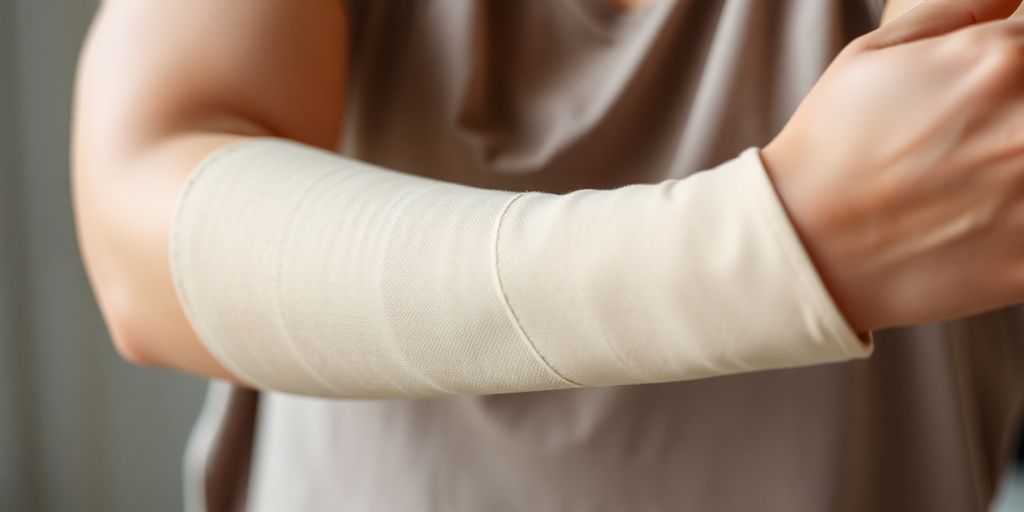Dealing with lymphedema can be tough, but knowing about compression wraps for lymphedema can really help. These special wraps are a big part of managing the swelling and discomfort that comes with this condition. This article will walk you through what lymphedema is, how compression wraps for lymphedema work, and give you some practical tips for using them. We'll also talk about finding affordable options and understanding insurance, so you can feel more in control of your treatment.
Key Takeaways
- Compression wraps for lymphedema are super important for handling swelling and making life better.
- Using your compression wraps for lymphedema correctly and replacing them when needed helps them do their job best.
- Your insurance might cover compression wraps for lymphedema if a doctor prescribes them, but check your plan because policies are different.
- There are programs out there that can help you pay for your compression wraps for lymphedema if money is tight.
- You can find good, effective compression wraps for lymphedema without spending a ton of money.
Understanding Lymphedema and the Role of Compression Wraps for Lymphedema

Defining Lymphedema and Its Causes
Okay, so what is lymphedema? Basically, it's when fluid builds up, usually in an arm or leg, because your lymphatic system isn't draining properly. Think of it like a backed-up plumbing system, but for your body. This can happen for a bunch of reasons. Sometimes it's because of surgery, especially if lymph nodes are removed. Other times, it's due to infections or even genetic conditions. The swelling can be uncomfortable, and if it's not taken care of, it can lead to other problems. It's a chronic condition, so managing it is key. Lymphedema is swelling that needs consistent care.
Importance of Compression in Managing Symptoms
So, why are compression wraps so important? They help move that fluid out of the affected area. It's like giving your lymphatic system a helping hand. The pressure from the wraps encourages the fluid to flow where it's supposed to go. Without compression, the fluid just sits there, causing more swelling and discomfort. It's a pretty simple concept, but it makes a huge difference. Think of it like squeezing a tube of toothpaste – you're applying pressure to move the contents along. Compression helps prevent complications and improves quality of life.
How Compression Wraps for Lymphedema Support Treatment
Compression wraps aren't a cure, but they're a big part of managing lymphedema. They work with other treatments, like manual lymphatic drainage, to reduce swelling and improve circulation. They also help prevent the fluid from building up again after treatment. It's all about consistent pressure and support. There are different types of wraps, and a therapist can help figure out which ones are best. Using a compression sleeve can provide comprehensive care.
Using compression wraps is like giving your body a gentle hug that encourages everything to flow the way it should. It's not a quick fix, but it's a really important part of keeping things under control and feeling better day to day.
Here's a quick rundown of how compression wraps help:
- Reduce swelling
- Improve circulation
- Prevent fluid buildup
- Support lymphatic drainage
Exploring Types of Compression Wraps for Lymphedema Available
Compression Sleeves for Upper Limb Support
Compression sleeves are made to help the upper limb, especially if you have lymphedema after surgery, pregnancy swelling, or carpal tunnel. These sleeves keep lymph flowing right, which lowers the chance of problems like slow-healing wounds. You can find these orthotic garments in different sizes and pressures to fit what you need, so they're comfy and work well.
Compression Stockings for Lower Limb Care
Compression stockings are key for taking care of your lower limbs. They put pressure that's tighter at the ankle and gets looser as it goes up your leg. This helps fluid go back up and eases symptoms of orthostatic hypotension. Using an elastic bandage or gauntlet with the stockings can give extra support and pressure where you need it. These stockings help keep fluid from building up and causing swelling.
- They help improve how well you move around.
- They lower the risk of problems.
- They make your life better overall.
Regular use of compression stockings can really make a difference. They help keep the pressure steady on your legs, which stops fluid from pooling and causing swelling. People find they can move around better and have fewer problems when they use these stockings regularly.
Utilizing Compression Wraps and Bandages
Compression wraps and bandages are a flexible way to deal with lymphedema. They're often used at the start of decongestive lymphatic therapy. Trained experts put them on to shrink the limb and help lymph flow better. These essential medical supplies are versatile and can be used in conjunction with a compression sleeve for comprehensive care. This mix makes sure the pressure is spread out evenly, which helps lymph flow right and stops problems.
Tips for Effective Use and Maintenance of Compression Wraps for Lymphedema
For those dealing with lymphedema, getting the most out of your compression wraps is key. It's not just about slapping them on; it's about doing it right and taking care of them so they last. This section will give you some pointers on how to do just that.
Proper Techniques for Wearing Garments
Putting on your compression garments the right way can make a huge difference. You want to make sure the pressure is even, going from your fingers or toes up towards your body. It's usually best to put them on first thing in the morning, before any swelling really kicks in.
Here's a quick rundown:
- Turn the wrap inside out, at least partway.
- Gently slide or roll it up your limb.
- Smooth out any wrinkles or folds.
If it feels too tight, it could cut off your circulation. If it's too loose, it won't do much good. Pay attention to how it feels and adjust as needed. If you're unsure, ask your doctor or therapist to show you the ropes.
Cleaning and Care Guidelines for Longevity
Keeping your wraps clean is important, not just for hygiene, but also to keep them working well. Always check the manufacturer's instructions, but generally, you'll want to:
- Hand wash them or use a gentle cycle in the washing machine.
- Use a mild detergent.
- Air dry them – don't toss them in the dryer!
Recognizing When to Replace Your Compression Wraps for Lymphedema
Compression wraps don't last forever. Over time, they lose their elasticity and don't provide as much support. Here are some signs it might be time for a new set:
- They feel looser than they used to.
- They're stretched out or misshapen.
- They're showing signs of wear and tear, like holes or fraying.
It's a good idea to keep an eye on how your wraps are performing and replace them when they start to lose their effectiveness. This will help you maintain consistent lymphedema management and prevent complications.
Maximizing Benefits Through Consistent Use of Compression Wraps for Lymphedema
Consistent use of compression wraps is super important for managing lymphedema. It's not a 'wear them when you feel like it' kind of thing. Think of it like taking medicine – you need to do it regularly to see results. When you wear your wraps consistently, you're helping to keep the swelling down and improving your overall comfort. Let's get into how to make this a regular part of your life.
Integrating Compression Wraps for Lymphedema into Daily Life
Okay, so how do you actually make wearing compression wraps a habit? Start by figuring out when it's easiest for you to put them on. For many, it's first thing in the morning, before any swelling really kicks in. Make it part of your routine, like brushing your teeth. Keep your wraps in a spot where you'll see them and remember to use them.
Here's a few ideas:
- Set a reminder on your phone.
- Keep your wraps next to your bed or in your bathroom.
- Pair it with another daily activity, like after you shower.
Making compression wraps a regular part of your day can feel like a chore at first, but the benefits are worth it. Think of it as an investment in your health and well-being. The more consistent you are, the better you'll feel, and the easier it will become.
Enhancing Mobility and Well-being with Regular Application
When you wear your compression wraps regularly, you'll probably notice a big difference in how you feel. Consistent compression helps to improve lymph fluid circulation, which reduces swelling and discomfort. This can lead to increased mobility and a better overall quality of life. You might find it easier to move around, exercise, and do the things you enjoy. It's not just about reducing swelling; it's about getting back to living your life.
Consider these benefits:
- Reduced swelling and pain.
- Increased range of motion.
- Improved energy levels.
Preventing Complications with Adherence to Therapy
Sticking to your compression therapy isn't just about feeling good today; it's also about preventing problems down the road. Lymphedema can lead to some serious complications if it's not managed properly. Consistent use of compression wraps helps to keep the condition under control and reduces the risk of infections, skin changes, and other issues. Think of it as a preventative measure to protect your long-term health.
Here's a quick look at potential complications of unmanaged lymphedema:
| Complication | Description |
|---|---|
| Cellulitis | A bacterial skin infection that can spread quickly. |
| Lymphangiosarcoma | A rare type of cancer that can develop in areas of long-term swelling. |
| Skin Changes | Thickening, hardening, or discoloration of the skin. |
Navigating Insurance and Financial Assistance Options for Compression Wraps for Lymphedema
Dealing with lymphedema is tough enough without having to stress about the cost of treatment. Let's be real, compression wraps aren't cheap, and figuring out how to pay for them can feel like a second job. This section breaks down how to get help with those costs, from understanding your insurance to finding programs that can offer financial aid.
Understanding Insurance Coverage Policies
Okay, so insurance. It's a headache, I know. But understanding your policy is the first step in getting those compression wraps covered. Most insurance companies, including Medicare, might cover compression garments, but only if your doctor prescribes them. The catch? Policies vary a lot. You'll need to call your insurance provider and ask them directly about their specific rules. They'll probably want a diagnosis code or some kind of proof that you really need the wraps. Don't skip this step – it could save you a ton of money. It's also important to select a compression garment provider that is in your insurance network.
Obtaining a Prescription for Compression Wraps for Lymphedema
So, you've checked your insurance, and it looks like they might cover compression wraps. Great! Now you need a prescription. This isn't just any prescription; it needs to be super specific. Your doctor will need to assess your lymphedema, figure out what kind of compression you need, and then write a prescription that includes all the details: pressure level, style, measurements – the whole shebang. This prescription is your golden ticket. You'll need it to prove to your insurance company that you need the wraps and to make sure you get the right size and type from the supplier.
Exploring Financial Aid and Assistance Programs
If insurance isn't enough, or if you don't have insurance, don't panic. There are other options. Lots of non-profit organizations and medical foundations have programs that can help with the cost of lymphedema treatment. These programs might offer grants or subsidies to cover the cost of compression garments. It's worth doing some digging to see what's out there. Here's a few things you can do:
- Check with national lymphedema organizations.
- Ask your doctor or therapist if they know of any local programs.
- Search online for
Affordable Solutions for Compression Wraps for Lymphedema Without Compromising Quality

It's true, dealing with lymphedema can be expensive, especially when you factor in the cost of compression wraps. But don't worry, there are ways to find affordable options without sacrificing quality. Let's explore some strategies to help you manage costs effectively.
Identifying Cost-Effective Compression Wraps for Lymphedema
Finding budget-friendly compression wraps for lymphedema doesn't mean you have to settle for less. Look for wraps made from durable, washable materials that will last. Sometimes, lesser-known brands offer similar quality to the big names but at a lower price point. Don't hesitate to read reviews and compare materials to make an informed decision. Also, keep an eye out for sales and discounts at medical supply stores or online retailers.
Comparing Ready-Made Versus Custom-Fitted Options
Ready-made compression wraps are generally more affordable than custom-fitted ones. Custom options are great if you need a specific fit, but for many, ready-made wraps work just fine. Consider starting with ready-made wraps and see if they meet your needs before investing in custom solutions. Here's a quick comparison:
| Feature | Ready-Made Wraps | Custom-Fitted Wraps |
|---|---|---|
| Cost | Lower | Higher |
| Availability | Readily Available | Made to Order |
| Fit | Standard Sizes | Personalized Fit |
| Best For | Mild to Moderate Lymphedema | Complex Cases |
Resources for Discounted or Subsidized Compression Wraps for Lymphedema
There are resources available to help ease the financial burden. Check with local charities, non-profit organizations, and government programs that may offer assistance. Some manufacturers also have patient assistance programs. Don't be afraid to ask your doctor or therapist for recommendations. They often know about local resources or have connections with suppliers who offer discounted lymphedema treatment garments.
It's important to remember that managing lymphedema is a long-term commitment. Finding affordable solutions is key to staying consistent with your treatment plan. Don't hesitate to explore all available options and advocate for your needs. With a little research and resourcefulness, you can find quality compression wraps that fit your budget.
Wrapping Things Up
So, we've talked a lot about compression wraps and how they help with lymphedema. It's pretty clear these wraps are a big deal for managing the condition. They really help with swelling and just make daily life a bit easier. Getting the right fit is super important, and taking care of your wraps makes them last. Also, don't forget to look into insurance and financial help, because these things can get pricey. The main takeaway? Compression wraps can make a real difference. They help people with lymphedema feel better and live more comfortably. It's all about finding what works for you and sticking with it.
Frequently Asked Questions
What exactly is lymphedema, and how do compression wraps help?
Lymphedema is swelling that happens when your body's fluid drainage system, called the lymphatic system, isn't working right. It often causes swelling in an arm or leg. Compression wraps help by gently squeezing the swollen area, which pushes the extra fluid out and back into your body's circulation.
What kinds of compression wraps are there?
There are different kinds! You have sleeves for your arms and stockings for your legs. There are also wraps and bandages that can be used for different body parts. The best type depends on where your swelling is and how bad it is.
How do I put on compression wraps the right way?
It's super important to put them on correctly so they work best. Usually, you put them on in the morning when swelling is lowest. Make sure they are smooth and snug, but not too tight. Your doctor or therapist can show you the right way.
Do I really need to wear my compression wraps every day?
Yes, consistency is key! Wearing your wraps regularly, as your doctor advises, helps control swelling, makes it easier to move around, and can stop other problems from happening. Think of it as a daily habit for better health.
Will my insurance pay for compression wraps?
It varies. Some insurance plans might cover them, especially if your doctor prescribes them. It's a good idea to call your insurance company and ask about their specific rules for compression garments for lymphedema.
Can I find affordable compression wraps that still work well?
Absolutely! You don't always need the most expensive option. There are many good quality, ready-made wraps that are more affordable. Sometimes, patient assistance programs or special clinics can also help you find lower-cost options.




Share:
Is It Good to Wear Compression Postpartum? Unpacking the Benefits and Best Practices
Unlock Your Potential: The Ultimate Guide to Compression Sleeves